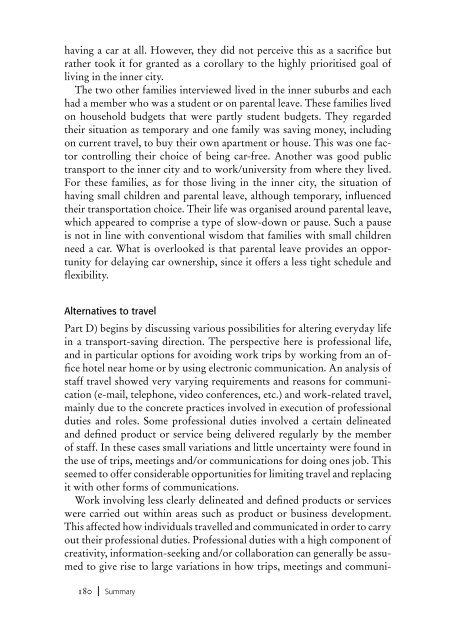Stockholmarnas resvanor - mellan trängselskatt och klimatdebatt
Stockholmarnas resvanor - mellan trängselskatt och klimatdebatt
Stockholmarnas resvanor - mellan trängselskatt och klimatdebatt
Create successful ePaper yourself
Turn your PDF publications into a flip-book with our unique Google optimized e-Paper software.
having a car at all. However, they did not perceive this as a sacrifice but<br />
rather took it for granted as a corollary to the highly prioritised goal of<br />
living in the inner city.<br />
The two other families interviewed lived in the inner suburbs and each<br />
had a member who was a student or on parental leave. These families lived<br />
on household budgets that were partly student budgets. They regarded<br />
their situation as temporary and one family was saving money, including<br />
on current travel, to buy their own apartment or house. This was one factor<br />
controlling their choice of being car-free. Another was good public<br />
transport to the inner city and to work/university from where they lived.<br />
For these families, as for those living in the inner city, the situation of<br />
having small children and parental leave, although temporary, influenced<br />
their transportation choice. Their life was organised around parental leave,<br />
which appeared to comprise a type of slow-down or pause. Such a pause<br />
is not in line with conventional wisdom that families with small children<br />
need a car. What is overlooked is that parental leave provides an opportunity<br />
for delaying car ownership, since it offers a less tight schedule and<br />
flexibility.<br />
Alternatives to travel<br />
Part D) begins by discussing various possibilities for altering everyday life<br />
in a transport-saving direction. The perspective here is professional life,<br />
and in particular options for avoiding work trips by working from an office<br />
hotel near home or by using electronic communication. An analysis of<br />
staff travel showed very varying requirements and reasons for communication<br />
(e-mail, telephone, video conferences, etc.) and work-related travel,<br />
mainly due to the concrete practices involved in execution of professional<br />
duties and roles. Some professional duties involved a certain delineated<br />
and defined product or service being delivered regularly by the member<br />
of staff. In these cases small variations and little uncertainty were found in<br />
the use of trips, meetings and/or communications for doing ones job. This<br />
seemed to offer considerable opportunities for limiting travel and replacing<br />
it with other forms of communications.<br />
Work involving less clearly delineated and defined products or services<br />
were carried out within areas such as product or business development.<br />
This affected how individuals travelled and communicated in order to carry<br />
out their professional duties. Professional duties with a high component of<br />
creativity, information-seeking and/or collaboration can generally be assumed<br />
to give rise to large variations in how trips, meetings and communi-<br />
180 Summary

















